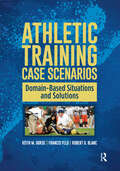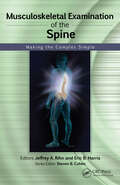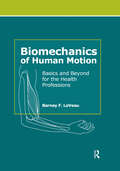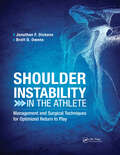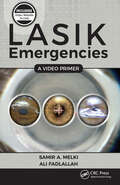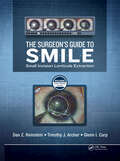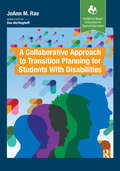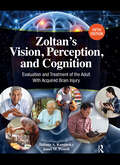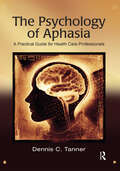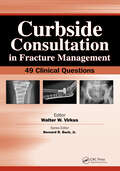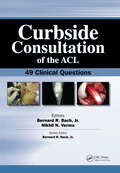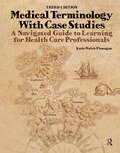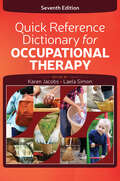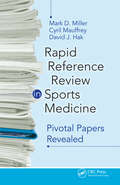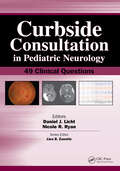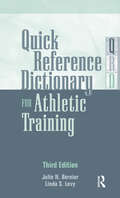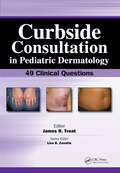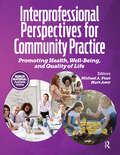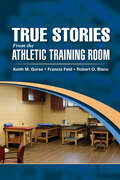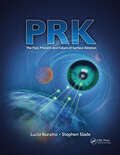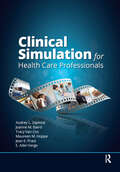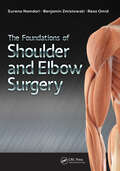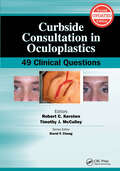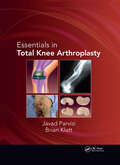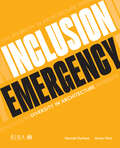- Table View
- List View
Athletic Training Case Scenarios: Domain-Based Situations and Solutions
by Francis Feld Keith Gorse Robert BlancEvery case that athletic trainers respond to is unique, but by exposing themselves to a variety of scenarios, they can be prepared for almost any situation. Case studies are the easiest way to find this information, but oftentimes, they come in the form of informal anecdotes or only relate to very specific subjects. Athletic Training Case Scenarios: Domain-Based Situations and Solutions is designed to fill this gap by providing a large number of studies from all five of the domains of athletic training. Keith M. Gorse, Francis Feld, and Robert O. Blanc have gathered true-to-life scenarios for each of the five domains of athletic training, resulting in expert advice on the best response to many possible scenarios. These scenarios were shared by the certified athletic trainers who originally responded to them coming from their work in industrial settings, high schools, colleges, professional teams, and sports medicine clinics. Each scenario features the actual case as it was first assessed by the athletic trainer in order to give readers an opportunity to use their own judgment and decide the best course of action before the original athletic trainer’s own response and recommendations are given. Organized by domain, readers will be able to easily find examples of any case they could imagine. Each domain (prevention, evaluation and diagnosis, emergency care, treatment and rehabilitation, and organizational and professional health) has over a dozen scenarios designed to encourage critical thinking. This format gives readers the closest thing to a crash-course by exposing them to a diverse array of cases and situations. Athletic training students and clinicians will appreciate the wide range of cases presented in Athletic Training Case Scenarios: Domain-Based Situations and Solutions, providing them with the strong knowledge base they will need to respond to any situation they may experience themselves.
Musculoskeletal Examination of the Spine: Making the Complex Simple
by Eric Harris Jeffrey RihnThe physical examination of the spine can be a complex topic for professionals with all levels of clinical experience. How can advance concepts be taught in a user-friendly, clear format, while still providing necessary information for effective diagnosis and treatment of the spine?Musculoskeletal Examination of the Spine: Making the Complex Simple by Drs. Jeffrey A. Rihn and Eric B. Harris answers these questions. Written by experts, this easy-to-carry book provides a thorough review of the most common pathologic spine conditions, techniques for diagnosis, as well as the appropriate treatment for each condition.Musculoskeletal Examination of the Spine: Making the Complex Simple contains clear photographic demonstrations, tables, and charts throughout its pages, allowing a thorough and concise examination of the spine.A Glance at some of what is covered inside:• Physical Examinationo Basics and specific tests of the examination of the cervical and thoracolumbar spine• General Imagingo Basics of general imaging of the degenerative and traumatic injuries of the spine• Common Conditionso Cervical spondylosis, Lumbar disk herniation, Diskitis and vertebral osteomyelitis of the spine, and moreMusculoskeletal Examination of the Spine: Making the Complex Simple contains essential information to successfully take a complex subject, and bring it to a level that will be welcomed by all orthopedic residents, attendings, physical therapists, athletic trainers, medical students in training, and other healthcare providers.
Biomechanics of Human Motion: Basics and Beyond for the Health Professions
by Barney LeVeauBiomechanics of Human Motion: Basics and Beyond for the Health Professions presents a straightforward approach to the basic principles, theories and applications of biomechanics and provides numerous techniques and examples for approaching biomechanical situations enhanced by healthcare professionals.Building on his previous work, Dr. Barney LeVeau uses clearly defined, concise terms and real-life applications rather than advanced mathematics to make teaching and learning biomechanics easier. Based upon the concept of force, the text illustrates how force is applied to the human body and how the body applies force to various objects. The emphasis is upon the pertinent factors that guide the reader to an understanding of biomechanics at a beginning level.Chapter Topics Include:• Strength of material such as loading and stress-strain relationships• Composition and Resolution of Forces such as graphic method and mathematical method• Equilibrium such as static, first condition and second condition• Dynamics such as kinematics and kinetics • Application such as stability and balance, motion analysis, and gaitWhat’s Inside:• Simple explanations of biological & mechanical concepts• Contemporary articles at the end of each chapter providing readers with information beyond the basics• Over 240 images illustrate biomechanical situations and computations• User-friendly, uncomplicated mathematical formulas and examplesBiomechanics of Human Motion: Basics and Beyond for the Health Professions provides students and clinicians of all allied health professions with a basic background and solid foundation on which to build a solid understanding of force and biomechanics.
Shoulder Instability in the Athlete: Management and Surgical Techniques for Optimized Return to Play
by Jonathan Dickens Brett OwensShoulder Instability in the Athlete: Management and Surgical Techniques for Optimized Return to Play is a groundbreaking text that covers all aspects of care for athletes with shoulder instability—from on-the-field management and treatment to successful return to play. Edited by Drs. Jonathan F. Dickens and Brett D. Owens and featuring the expertise of internationally recognized surgeons who specialize in shoulder instability in high-level athletes, Shoulder Instability in the Athlete is a unique collaboration applicable across a variety of professional areas. This will be the premiere reference for physicians, surgeons, therapists, trainers, and students involved in the care of athletes. Each chapter of Shoulder Instability in the Athlete reviews cutting-edge clinical and surgical techniques, as well as outcomes and return to play criteria. In-depth analysis of appropriate literature and outcomes specific to the athlete population are also presented. Important sections within the text include: Principles for the team physician Anterior instability Posterior instability Special topics in instability By focusing specifically on the unique and challenging dilemma of caring for the athlete with shoulder instability, Shoulder Instability in the Athlete will be a valuable reference for all health professionals who manage athletes.
LASIK Emergencies: A Video Primer
by Samir A. Melki Ali FadlallahFemtosecond-assisted laser in-situ keratomileusis flaps have revolutionized refractive surgery since their introduction. The use of the femtosecond laser to create the LASIK flap has led to an improvement in the safety profile of the flap creation step as compared to the mechanical microkeratome. Although this laser is exceedingly safe, complications still do occur. LASIK Emergencies: A Video Primer focuses specifically on the different flap complications that are still known to occur and their management.Designed as a narrated video-based book of ophthalmic surgeries, LASIK Emergencies covers the entire spectrum of Intralase flap complications. With 15 chapters, this book and accompanying website contains nearly 4 hours of state-of-the-art video teaching.Drs. Samir Melki and Ali Fadlallah have designed LASIK Emergencies so that each chapter focuses on a specific complication and its management, and features multiple videos for each. Each video is edited in such a way that the viewer can quickly grasp all the relevant information without having to sit through extensive, unedited surgical videos.Some Complications Covered: Loss of suction Air bubbles in the Anterior Chamber Irregular Flaps Subconjunctival hemorrhage and bleeding Ophthalmologists, laser ophthalmic technicians, and optometrists alike will appreciate this unique resource, as LASIK Emergencies: A Video Primer covers the entire spectrum of LASIK complications in a detailed, yet digestible manner.
The Surgeon’s Guide to SMILE: Small Incision Lenticule Extraction
by Dan Reinstein Timothy Archer Glenn CarpCorneal refractive surgeons are likely already familiar with the theory behind small incision lenticule extraction (SMILE) and the excellent postoperative outcomes it can achieve, but they were left without a thorough and comprehensive guide to performing the procedure, until now. The Surgeon’s Guide to SMILE: Small Incision Lenticule Extraction is designed to provide surgeons who are interested in starting or are already performing SMILE with a detailed description of the preoperative assessment, surgical technique, and postoperative management of SMILE treatments.This book by Professor Dan Z. Reinstein, Mr. Timothy J. Archer, and Dr. Glenn I. Carp is designed as a surgical video-fellowship, focusing on the granular details of every aspect of patient preparation and management with special attention to how to perform a perfect routine SMILE procedure. The protocols and methods are sourced in both the published scientific evidence and the extensive experience and expertise of the authors. It also includes tips and tricks of how to manage the full range of possible scenarios and complications that can occur during and after a SMILE surgery. Each process described in the book is accompanied by at least one, and in many cases numerous, narrated video examples.Bonus!This dynamic learning tool is supplemented by the SMILE video library containing over 16 hours of surgical videos and tutorials hosted on a companion website.The succinct and demonstrative style of The Surgeon’s Guide to SMILE: Small Incision Lenticule Extraction will help novice and experienced SMILE surgeons alike learn important techniques and improve their outcomes.From the Foreword:“The reader is in for a treat, receiving authoritative technical information from seasoned leaders in the field of refractive surgery, who have attained tremendous experience in excimer laser ablation and who have also been on the forefront of scientific evaluation of the new femtosecond only surgical approach that is SMILE.”-J. Bradley Randleman, MD, University of Southern California, Los Angeles, CA
A Collaborative Approach to Transition Planning for Students with Disabilities (Evidence-Based Instruction in Special Education)
by JoAnn M. RaeA Collaborative Approach to Transition Planning for Students with Disabilities is designed to inform aspiring special education teachers, special education teams, transition planning specialists and school administrators about the complex process of transition planning and to meet the transition requirements of special education legislation. Author Dr. JoAnn Rae has been in the field of special education for 34 years, in service as a special education teacher, special education administrator, teacher certification supervisor and as college faculty. The framework she outlines is specially designed to advance students’ involvement and participation in their lives, not only in the presence of the most severe sensory and intellectual disabilities, but also in the case of multiple disabilities. Unique scenarios not typically seen in other textbooks, such as IEP team disagreements, students with terminal illnesses, students with ill or overworked parents or students living in poverty are also explored. The text also includes: Descriptions of research-based practices to maximize students’ self-determination, autonomy, goal setting and ability to have successful life experiences Opportunities to integrate knowledge with practice by providing strategies that relate to the real-life difficulties students and transition planning specialists may encounter Easy-to-replicate communication tools, such as letters to students and parents, as examples to enhance collaboration Methods for teachers to effectively promote and increase student involvement and collaboration by using structured and interactive interviews A Collaborative Approach to Transition Planning for Students with Disabilities reflects the universal challenges that teachers, families and finally, the students themselves face, as they progress through school with a disability. For students with disabilities, the key component to successful transition planning is creating a collaborative atmosphere that allows them to be successful. This book promises to serve as an essential resource to all who are dedicated to that goal.
Zoltan’s Vision, Perception, and Cognition: Evaluation and Treatment of the Adult with Acquired Brain Injury
by Tatiana Kaminsky Janet PowellThe go-to guide for nearly 50 years for occupational therapists working with adults with visual, perceptual, and cognitive deficits after brain injury is back for a Fifth Edition.Zoltan’s Vision, Perception, and Cognition: Evaluation and Treatment of the Adult With Acquired Brain Injury, Fifth Edition maintains the core foundation laid in previous editions while drawing upon Drs. Tatiana A. Kaminsky and Janet M. Powell’s 60-plus years combined of clinical, teaching, and research experience in adult neuro-based rehabilitation.This best-selling text translates the available research and theory into application for practice. The result is a comprehensive, accessible, up-to-date, and evidence-informed textbook with a strong occupation-based focus, detailing occupational therapy evaluation and treatment practices for adults with visual, perceptual, and cognitive deficits after brain injury.What’s new in the Fifth Edition: An emphasis on functional cognition, occupational focus, and changes in approaches to rehabilitation Clinical examples from adult neurorehabilitation to ease understanding Up-to-date evidence and everyday technology implementation Tips for collaborating with a team of practitioners New case examples Included with the text are online supplemental materials for faculty use in the classroom.Zoltan’s Vision, Perception, and Cognition: Evaluation and Treatment of the Adult With Acquired Brain Injury, Fifth Edition includes key updates to stay current while maintaining the essence of its previous editions.
The Psychology of Aphasia: A Practical Guide for Health Care Professionals
by Dennis TannerBrain damage predisposes many persons with aphasia to a variety of psychological reactions, which are precipitated by stress and loss, and perpetuated by impaired verbal defense mechanisms and coping styles. Most of the literature on recovery from aphasia does not sufficiently address the overwhelming confusion and disorder that aphasia can cause in the patient, the communication partner, the communication between them, and their shared environment. The Psychology of Aphasia: A Practical Guide for Health Care Professionals fills this serious void.Dr. Dennis Tanner has studied the psychology of aphasia as a scientist and professor as well as evaluated and treated thousands of patients with neuropathologies of speech and language as a clinician over his 40-year career. This text represents the culmination of his efforts to understand the major psychological aspects of this complex communications disorder.The only text specifically addressing this topic, The Psychology of Aphasia is designed to provide the reader with a sound foundation of scientific information with current and historical scientific references spanning many decades. It delves into the certain psychological, emotional, and behavioral reactions that occur because of brain and nervous system damage, the psychological defenses and coping styles of patients and the verbal defense mechanisms they are deprived of due to their loss of language, as well as the grief response to the loss of physical abilities, valued objects, and the breakdown in communication.Each chapter is written in accessible language and provides practical case studies, illustrations, and examples of each major concept to reinforce learning.The whole aphasia rehabilitation team of speech-language pathologists, psychologists, physical and occupational therapists, social workers, physicians, nurses, home health aides, and family members will find The Psychology of Aphasia: A Practical Guide for Health Care Professionals an enlightening tool to bridge the gap between theoretical and practical issues in treating actual patients.
Curbside Consultation in Fracture Management: 49 Clinical Questions (Curbside Consultation in Orthopedics)
by Walter VirkusAre you looking for concise, practical answers to those questions that are often left unanswered by traditional fracture management references? Are you seeking brief, evidence-based advice for complicated cases or controversial decisions? Curbside Consultation in Fracture Management: 49 Clinical Questions provides quick answers to the thorny questions most commonly posed during a “curbside consultation” between orthopedic surgical colleagues. Dr. Walter Virkus has designed this unique reference which offers expert advice, preferences, and opinions on tough clinical questions commonly associated with fracture management. The unique Q&A format provides quick access to current information related to fracture management with the simplicity of a conversation between two colleagues. Numerous images, diagrams, and references are included to enhance the text and to illustrate the management of fractures.Curbside Consultation Fracture Management: 49 Clinical Questions provides information basic enough for residents while also incorporating expert advice that even high-volume clinicians will appreciate. Practicing orthopedists, orthopedic residents, and non-physician personnel will benefit from the user-friendly and casual format and the expert advice contained within.Some of the questions that are answered: • There is a patient in the ER with a femur fracture and humeral shaft fracture. Should I fix the humerus with a nail or a plate? • How do you decide which pelvis fractures need surgery? • What is your choice for a displaced femoral neck fracture in a 65-year-old: ORIF, hemiarthroplasty, or total hip arthroplasty? • I have a 45 Year-old woman with a bicondylar tibial plateau fracture. What type of fixation should I use? • I have a 38 Year-old woman with a distal tibia spiral fracture. Should I try to nail this or just plate it? • When do you use locking plates?
Curbside Consultation of the ACL: 49 Clinical Questions (Curbside Consultation in Orthopedics)
by Nikhil N. Verma Bernard R. BachAre you looking for concise, practical answers to those questions that are often left unanswered by traditional ACL references? Are you seeking brief, evidence-based advice for complicated cases or complications? Curbside Consultation of the ACL: 49 Clinical Questions provides quick answers to the many questions most commonly posed during a “curbside consultation” between surgical colleagues. Drs. Bernard R. Bach, Jr. and Nikhil N. Verma have designed this unique reference which offers expert advice, preferences, and opinions on tough clinical questions commonly associated with ACL management. The unique Q&A format provides quick access to current information related to ACL management with the simplicity of a conversation between two colleagues. Numerous images, diagrams, and references are included to enhance the text and to illustrate the management of ACL issues.Curbside Consultation of the ACL: 49 Clinical Questions provides information basic enough for residents while also incorporating expert advice that even high-volume clinicians will appreciate. Practicing orthopedic surgeons, orthopedic residents and medical students will benefit from the user-friendly and casual format and the expert advice contained within.Some of the questions that are answered: How do you evaluate the failed ACL reconstruction? What tricks do you have to avoid creation of a “vertical” tunnel when drilling a transtibial tunnel? How do you evaluate, manage, and prevent motion problems? How do you determine tibial tunnel position to optimize graft length and femoral tunnel position when performing an endoscopic technique? How do you manage the expanded femoral or tibial tunnel in a failed ACL patient? How do you manage the adolescent with open growth plates who has sustained an ACL injury?
Medical Terminology with Case Studies: A Navigated Guide to Learning for Health Care Professionals
by Katie Walsh FlanaganMedical Terminology With Case Studies: A Navigated Guide to Learning for Health Care Professionals, Third Edition, is a fun, engaging, and easy-to-read resource on medical terminology for allied health students in athletic training, occupational therapy, physical therapy, and more.Featuring such memorable characters as Skully, the pirate skeleton, and Tango, his trusty parrot, Medical Terminology With Case Studies contains colorful illustrations throughout the text along with tear-out worksheets for students at the end of each chapter. The book is appropriate for students in both college and high school settings.The textbook is divided into three sections, each one covering key concepts and ideas related to medical terminology: Section I: A general overview of medical terminology, delving into its uses, purposes, and career-specific applications across specialties Section II: An in-depth examination of the specific body systems (musculoskeletal, cardiovascular, respiratory, neurological, gastrointestinal, integumentary, endocrine, urinary, reproductive, and sensory) and the associated prefixes, suffixes, and combining forms that go along with them Section III: Appendices, including medical abbreviations, ICD/CPT medical coding, and pharmacology terms Updated features in the Third Edition include: New terms throughout Updated graphics throughout New case studies New chapter on health professions Updated chapter bibliographies Included with the text are online supplemental materials for faculty use in the classroom.Combining bright, colorful characters with easy-to-read resources, Medical Terminology With Case Studies: A Navigated Guide toLearning for Health Care Professionals, Third Edition, is an invaluable terminology guide for allied health students.
Quick Reference Dictionary for Occupational Therapy
by Karen Jacobs Laela SimonA leading resource for occupational therapy practitioners and students for 20 years, now updated with the latest information in the profession, Quick Reference Dictionary for Occupational Therapy, Seventh Edition is a resource for daily practice and academic training. Quick Reference Dictionary for Occupational Therapy, Seventh Edition by Dr. Karen Jacobs and Laela Simon remains the only comprehensive dictionary available specifically for occupational therapy. Containing more than 4,000 words and definitions, more than 60 appendices, and illustrations, graphs, and tables throughout, this definitive text has been updated with the latest information in current occupational therapy practice. New appendices in the Seventh Edition include: Commonly Used Assessments Emerging Practice Areas Expand Your Knowledge Grading Versus Adapting a Task Hand Pathologies State Regulatory Entities Theories and Frames of Reference Useful Apps A handy, conveniently sized reference in an easy-to-use format, Quick Reference Dictionary for Occupational Therapy, Seventh Edition gives occupational therapists, occupational therapy assistants, faculty, and students the most pertinent information they need day to day, right at their fingertips.
Rapid Reference Review in Sports Medicine: Pivotal Papers Revealed
by Mark Miller Cyril Mauffrey David HakAs medical information expands at an exponential pace, the ability to quickly identify relevant articles becomes increasingly difficult.Rapid Reference Review in Sports Medicine: Pivotal Papers Revealed by Drs. Mark D. Miller, Cyril Mauffrey and David J. Hak offers a simple way to access and review the key points from the most relevant and important published articles. With Rapid Reference Review in Sports Medicine: Pivotal Papers Revealed orthopedic trainees may be able to quickly review several articles in preparation for a morning conference presentation of patients with a specific injury, while practicing surgeons may be able to advise patients on the relative benefits of one treatment over another.Key references include: • Classic articles • Landmark articles • Up-to-date reviews • Important clinical trials Each article is formatted to include an article citation, a summation of the abstract, a summary of key points, and author commentary. This enables readers to quickly review “bottom-line” information from the most important articles and clinical trials in orthopedic sports medicine in order to effectively plan and guide treatment.Rapid Reference Review in Sports Medicine: Pivotal Papers Revealed is a great literary reference that will prove highly useful to orthopedic residents, fellows, and physician assistants.
Curbside Consultation in Pediatric Neurology: 49 Clinical Questions (Curbside Consultation in Pediatrics)
by Daniel Licht Nicole RyanAre you looking for concise, practical answers to those questions that are often left unanswered by traditional pediatric neurology references? Are you seeking brief, evidence-based advice for complicated cases or controversial decisions? Curbside Consultation in Pediatric Neurology: 49 Clinical Questions provides quick answers to the tricky questions most commonly posed during a “curbside consultation” between pediatricians. Dr. Daniel Licht and Dr. Nicole R. Ryan have designed this unique reference which offers expert advice, preferences, and opinions on tough clinical questions commonly associated with pediatric neurology. The unique Q&A format provides quick access to current information related to pediatric neurology with the simplicity of a conversation between two colleagues. Numerous images, diagrams, and references allow readers to browse large amounts of information in an expedited fashion.Some of the questions that are answered: When should I consider head imaging in a child with headache? CT or MRI? What is the acute management after a concussion? When can a child return to school and sports? What are the important things to consider when you see a child with the complaint of vision changes? Are there any diet changes or vitamins that may help a child with epilepsy? What are the signs of a stroke in a child? Are there other conditions that can present like a stroke? What are common causes of acute ataxia? What are the neurodevelopmental disorders leading to language delay and what work-up is needed? What are the Causes of Guillain-Barré Syndrome, How Often Does It Occur, and How Do You Treat It? Curbside Consultation in Pediatric Neurology: 49 Clinical Questions provides information basic enough for residents while also incorporating expert advice that even high-volume pediatricians will appreciate. Pediatricians, family practitioners, and pediatric residents will benefit from the user-friendly, casual format and the expert advice contained within.
Quick Reference Dictionary for Athletic Training
by Linda Levy Julie N. BernierFor more than 10 years, the Quick Reference Dictionary for Athletic Training has assisted clinicians and students in applying current concepts applicable to the profession while in the classroom, clinic, or on the field.Now updated into a Third Edition, this pocket-sized, comprehensive, and user-friendly companion guide is an essential resource from Dr. Julie N. Bernier and Dr. Linda S. Levy.With over 2100 terms and 20 appendices, the Quick Reference Dictionary for Athletic Training, Third Edition includes a more complete series of neurologic and musculoskeletal special tests, as well as available evidence-based data including likelihood ratios, and interrater and intrarater reliability data to support the use of each test.Additional updates include:• References to accreditation• Goniometric range of motion measures• Pharmacology• Concussion assessment protocol• The NATA’s Code of EthicsThe Quick Reference Dictionary for Athletic Training, Third Edition will textually and visually provide the athletic training clinician and student with a quick overview of the essential elements of the profession.
Curbside Consultation in Pediatric Dermatology: 49 Clinical Questions (Curbside Consultation in Pediatrics)
by James TreatAre you looking for concise, practical answers to those questions that are often left unanswered by traditional pediatric dermatology references? Are you seeking brief, evidence-based advice for complicated cases or controversial decisions? Curbside Consultation in Pediatric Dermatology: 49 Clinical Questions provides quick answers to the tricky questions most commonly posed during a “curbside consultation” between pediatricians. Dr. James Treat has designed this unique reference which offers expert advice, preferences, and opinions on tough clinical questions commonly associated with pediatric dermatology. The unique Q&A format provides quick access to current information related to pediatric dermatology with the simplicity of a conversation between two colleagues. Numerous images, diagrams, and references allow readers to browse large amounts of information in an expedited fashion. Curbside Consultation in Pediatric Dermatology: 49 Clinical Questions provides information basic enough for residents while also incorporating expert advice that even high-volume pediatricians will appreciate. Pediatricians, nurse practitioners, physician assistants and family practitioners will benefit from the user-friendly, casual format and the expert advice contained within. Some of the questions that are answered: • How should I be working up and managing my patients with congenital nevi?• How do I manage patients with severe atopic dermatitis?• Which patients with hemangioma do I have to worry about?• What do I need to think about for children with cafe au lait macules?• Is there an algorithm for treating my acne patients?
Interprofessional Perspectives for Community Practice: Promoting Health, Well-Being, and Quality of Life
by Michael Pizzi Mark AmirNow more than ever health care professionals play an increased role in the promotion of health to populations. Unique and innovative, Interprofessional Perspectives for Community Practice: Promoting Health, Well-being and Quality of Life weaves everyday care into prevention, community, and population health, creating a new and more expansive vision of health for all without compromising traditional practices.Authors and editors Drs. Pizzi and Amir discuss and illustrate a client-centered preventive and health, well-being and quality of life approach rooted in best practice principles from interprofessional literature and firsthand experience. The text illustrates how allied health professionals implement those principles in their everyday and traditional practices with an emphasis on exploring health and well-being issues. Interprofessional Perspectives for Community Practice provides detailed guidance in program development and implementation.What’s included in Interprofessional Perspectives for Community: Clinical anecdotes on successful community practices A focus on primary and secondary prevention Assessments, interventions, and community practice examples Descriptions of community-based practice settings such as adult day care, independent living programs, hospice, and home health care Health and wellness across the lifespan Bonus chapters available online as PDFs for readers The first text of its kind to weave interprofessionalism, community practice, and health, well-being, and quality of life, Interprofessional Perspectives for Community Practice: Promoting Health, Well-being and Quality of Life is for all health care workers and students who wish to transfer practice skills from the clinical setting to a population-based program development model.
True Stories From the Athletic Training Room
by Francis Feld Keith Gorse Robert BlancAre you a student who has made the exciting decision to become an athletic trainer? Are you a faculty member looking to share with your students lessons, tips, and examples of what they can expect from this challenging and rewarding profession? Are you a new clinician just beginning your career and looking ahead to many fulfilling years of working with athletes? Then True Stories from the Athletic Training Room is the perfect text for you.True Stories from the Athletic Training Room is a collection of 35 true-to life stories shared by certified athletic trainers from their work in industrial settings, high schools, colleges, professional teams, and sports medicine clinics. Brought together by Keith M. Gorse, Francis Feld and Robert O. Blanc, True Stories from the Athletic Training Room is organized by the five domains of athletic training: Injury and Illness Prevention and Wellness Protection Clinical Evaluation and Diagnosis Immediate and Emergency Care Treatment and Rehabilitation Organizational and Professional Health and Well-being With this user-friendly organization, readers will be able to easily find examples of any true story they could imagine. Each story features the actual occurrence as it was told by the certified athletic trainer and gives the readers an opportunity to get a genuine feel of what the athletic training profession is really all about, with just a turn of the page.True Stories from the Athletic Training Room will provide athletic training students, faculty, and clinicians the closest thing to a crash-course by exposing them to a diverse array of true to life occurrences about the past and present of health care management in sports and active lifestyles.
PRK: Past, Present, and Future
by Lucio Buratto Steven G. Slade Sebastiano Serrao Marco LombardoModern laser vision correction has continually changed since its inception. The evolution of this procedure has been aided by broad technological advancements, increased surgical knowledge, and increased understanding of the cornea and its response to lasers.PRK: The Past, Present, and Future of Surface Ablation will provide a complete vision of the PRK laser correction techniques that have emerged and the technological advancements that have made them possible. The collaboration of Drs. Buratto, Slade, Serrao, and Lombardo, along with a team of international surgeons have produced a complete book specifically designed to assist clinician’s to improve the quality of their patient’s visionWith over 85 color illustrations demonstrating the various procedures and concepts, the book will help ophthalmologists develop a more thorough understanding of PRK. PRK: The Past, Present, and Future of Surface Ablation is excellent for surgeons interested in learning the concepts, developing skills, and preparing for the actual laser procedure. This definitive resource couples both the authors' and 9 contributors' diverse experience and knowledge to produce a complete vision of PRK laser vision correction. PRK: The Past, Present, and Future of Surface Ablation will be the definitive resource necessary for all surgeons aspiring to improve their surgical results using the latest techniques available.
Clinical Simulation for Healthcare Professionals
by Audrey L. Zapletal Joanne M. Baird Tracy Van Oss Maureen M. Hoppe Jean E. Prast E. Adel HergeAs simulated learning experiences are increasingly used in healthcare education to enhance student engagement and experience, Clinical Simulation for Healthcare Professionals serves as a resource for the utility, design, and implementation of simulation-based education in occupational therapy, physical therapy, speech-language pathology, and nursing.Using best practice methods, academic and clinical rehabilitation professionals of all levels will learn how to design and implement clinical simulations. These can be used as a tool for education, assessment, research, and skills integration.Written by Drs. Audrey Zapletal, Joanne Baird, Jean Prast, Maureen Hoppe, Tracy Van Oss, and Adel Herge, Clinical Simulation for Healthcare Professionals provides comprehensive information about commonly used simulation methods including high and low technology simulations, simulated patients, task trainers, and role play. Also included are step-by-step instructions for how to build simulation experiences in a variety of settings and for various learning and teaching needs. How-to information assists instructors who want to develop and integrate simulation-based education into a new or existing curriculum.The example simulations inside represent an array of different practice and focus uses. Each stage of the simulation is addressed from creation to learning assessment to debriefing.Simulation integrates the worlds of education, health professions, and the performing arts within a singular enriching experience. Clinical Simulation for Healthcare Professionals fulfills a need for educators looking to develop the skills needed to create complex and dynamic learning environments.
The Foundations of Shoulder and Elbow Surgery
by Surena Namdari Benjamin Zmistowski Reza OmidA comprehensive introductory text with more than 150 color images and figures, The Foundations of Shoulder and Elbow Surgery provides essential information on shoulder and elbow care for students, residents, fellows, and new doctors.Surgery of the shoulder and elbow has grown more common in recent decades as understanding of anatomy, physiology, and pathology has improved. Additionally, innovations in surgical techniques and implant design have given surgeons the tools to address a higher number of shoulder and elbow pathologies. To adequately care for this increasing patient population, the basics of shoulder and elbow care must be disseminated to those in training.Together with their expert contributors, Drs. Surena Namdari, Benjamin Zmistowski, and Reza Omid explore the foundational concepts of shoulder and elbow surgery, including: Shoulder anatomy and physical examination, shoulder instability, and rotator cuff disease Frozen shoulder (adhesive capsulitis) and injuries to the biceps-labral complex Shoulder arthritis (glenohumeral arthritis), shoulder fractures, and the athlete’s shoulder and elbow Scapular disorders and acromioclavicular disorders Elbow anatomy and physical exam, elbow instability, and tendon injuries Neuropathies of the upper extremity Elbow arthritis, fractures of the elbow, and humeral shaft fractures In conjunction with clinical experience, The Foundations of Shoulder and Elbow Surgery will serve as an invaluable resource for orthopedic surgeons-in-training.
Curbside Consultation in Oculoplastics: 49 Clinical Questions (Curbside Consultation in Ophthalmology)
by Robert Kersten Timothy McCulleyCurbside Consultation in Oculoplastics has been updated into a Second Edition! The Second Edition contains new questions and is completely updated! Curbside Consultation in Oculoplastics: 49 Clinical Questions, Second Edition contains new questions and brief, practical, evidence-based answers to the most frequently asked questions that are posed during a “curbside consultation” between surgical colleagues. Dr. Robert C. Kersten and Dr. Timothy J. McCulley have designed this unique reference in which oculoplastic specialists offer expert advice, preferences, and opinions on tough clinical questions commonly associated with ocuplastics. The unique Q&A format provides quick access to current information related to oculoplastics with the simplicity of a conversation between two colleagues. Images, diagrams, and references are included to enhance the text and to illustrate common clinical dilemmas.Some of the questions that are answered inside theSecond Editioninclude: What lasers do you prefer for facial resurfacing? When do you worry that an eyelid growth is malignant? What are the general treatment guidelines for graves ophthalmopathy? How do I know when to order and MRI or CT? What is the best approach to manage trichiasis? How do I decide whether to perform an enucleation or an evisceration? Curbside Consultation in Oculoplastics: 49 Clinical Questions, Second Edition provides information basic enough for residents while also incorporating expert pearls that even high-volume ophthalmologists will appreciate. Residents, fellows, and practicing physicians alike will benefit from the user-friendly, casual format and the expert advice contained within.
Essentials in Total Knee Arthroplasty
by Javad Parvizi Brian KlattEssentials in Total Knee Arthroplasty is a succinct, yet comprehensive book that provides a unique look into the world of total knee arthroplasty (TKA), beginning with an in-depth history of this common procedure, and then progressing to strategies that will manage, treat, and prevent complications.Inside the pages of Essentials in Total Knee Arthroplasty, Dr. Javad Parvizi and Dr. Brian Klatt, along with more than 40 contributors, cover a wide-range of topics, including: Knee biomechanics and biomaterials Surgical approaches to TKA Postoperative Analgesia Options for the Total Knee Arthroplasty Patient Controversies in TKA Mechanisms of failure in TKA Complex primary total TKA TKA revision TKA rehabilitation With over 100 color images, clear & descriptive text, and a forward thinking approach to clinical and basic research in the reconstruction of the knee, Essentials in Total Knee Arthroplasty will become the "go-to" book for orthopedic residents, fellows, junior attendings, medical students, and physical therapists involved with all matters related to total knee arthroplasty.
Inclusion Emergency: Diversity in architecture
by Hannah Durham Grace ChoiArchitecture is at a tipping point. Voices of the under-represented have been increasing in volume and are agitated for change. If we don’t collectively listen, re-adjust and change our future outlook, we limit the potential relevance of the profession in today’s society and, ultimately, the places we create. Capturing insight from leading voices in the profession, this book encourages understanding, reflection and addresses critical questions, providing steps towards meaningful change. It will help those who are under-represented to find role models, context and tools & to be confident, supported and valued. Building understanding for those more privileged to acknowledge bias, it will enable mitigation and awareness of the issues to encourage meaningful action. This is a call for change. Now.
